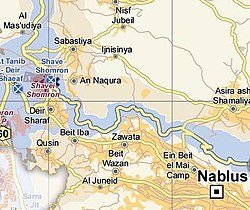Sebastia | |
|---|---|
| Arabic transcription(s) | |
| • Arabic | سبسطية |
| • Latin | Sabastiya Sabastia Sebaste (unofficial) |
 View of Sebastia, 2016 | |
 Sabastiya in the 2018 OCHA OpT map; the archeological site of Samaria is located immediately east of the built up area | |
| Coordinates: 32°16′36″N 35°11′45″E / 32.27667°N 35.19583°E | |
| Palestine grid | 168/186 |
| State | State of Palestine |
| Governorate | Nablus |
| Government | |
| • Type | Municipality (from 1997) |
| • Head of Municipality | Ma’amun Harun Kayed[1] |
| Area | |
• Total | 4,810 dunams (4.8 km2 or 1.9 sq mi) |
| Population (2017)[2] | |
• Total | 3,205 |
| • Density | 670/km2 (1,700/sq mi) |
Sebastia (Arabic: سبسطية, Sabastiyah; Greek: Σεβαστη, Sevasti; Hebrew: סבסטיה, Sebastiya; Latin: Sebaste) is a Palestinian village of about 3,205 inhabitants,[2] located in the Nablus Governorate of the State of Palestine, some 12 kilometers northwest of the city of Nablus.[3]
Sebastia is believed to be one of the oldest continuously inhabited places in the West Bank.[4][5][6] In the 9th century BCE, it was known as Samaria, and served as the capital city of the northern Kingdom of Israel until it was destroyed by the Neo-Assyrian Empire around 720 BCE.[7][4][5][8] It became an administrative center under Assyrian, Babylonian and Persian rule.[5] During the early Roman period, the city was expanded and fortified by Herod the Great, who renamed it Sebastia in honor of emperor Augustus.[9][10] Since the middle of the 4th century, the town has been identified by Christians and Muslims as the burial site of John the Baptist, whose purported grave is today part of Nabi Yahya Mosque.[11][6] Conquered by Muslims in the 7th century, the present-day village of Sebastia is home to a number of important archaeological sites.[12][13]
- ^ Municipalities Archived 2007-02-21 at the Wayback Machine Nablus Municipality
- ^ a b Preliminary Results of the Population, Housing and Establishments Census, 2017 (PDF). Palestinian Central Bureau of Statistics (PCBS) (Report). State of Palestine. February 2018. pp. 64–82. Retrieved 2023-10-24.
- ^ "Nablus". Retrieved 2007-09-14.[permanent dead link]
- ^ a b "Sebastia". UNESCO World Heritage Centre. Retrieved 2022-02-26.
- ^ a b c Pummer, Reinhard (2019-12-20). "Samaria". The Encyclopedia of Ancient History: 1–3. doi:10.1002/9781444338386.wbeah11208.pub2. ISBN 9781405179355. S2CID 241784278.
- ^ a b "Sebastia | Nablus, Palestinian Territories Attractions". Lonely Planet. Retrieved 2021-08-14.
- ^ Schipper, Bernd U. (2021-05-25). "Chapter 3 Israel and Judah from 926/925 to the Conquest of Samaria in 722/720 BCE". A Concise History of Ancient Israel. Penn State University Press. pp. 34–54. doi:10.1515/9781646020294-007. ISBN 978-1-64602-029-4.
- ^ Hennessy, J. B. (1970). "Excavations at Samaria-Sebaste, 1968". Levant. 2 (1): 1–21. doi:10.1179/007589170790216981. ISSN 0075-8914.
- ^ Barag, Dan (1993-01-01). "King Herod's Royal Castle at Samaria-Sebaste". Palestine Exploration Quarterly. 125 (1): 3–18. doi:10.1179/peq.1993.125.1.3. ISSN 0031-0328.
- ^ Dell’Acqua, Antonio (2021-09-20). "The Urban Renovation of Samaria–Sebaste of the 2nd and 3rd centuries CE: Observations on some architectural artefacts". Palestine Exploration Quarterly. 154 (3): 221–243. doi:10.1080/00310328.2021.1980310. ISSN 0031-0328. S2CID 240589831.
- ^ "General Audience of 29 August 2012 | BENEDICT XVI". www.vatican.va. Retrieved 2022-05-18.
- ^ United Nations Development Programme (23 April 2003). "Spain helps restore Sebastia, Palestinian town with historic sites". United Nations. Retrieved 2007-09-14.
- ^ For excavations conducted during the Ottoman period, see Reisner, G.A.; Fisher, C.S.; Lyon, D.G. (1924). Harvard Excavations at Samaria, 1908–1910 (2 vols. ed.). Cambridge, Massachusetts: Harvard University Press.. See also: The Augusteum at Samaria-Sebaste

